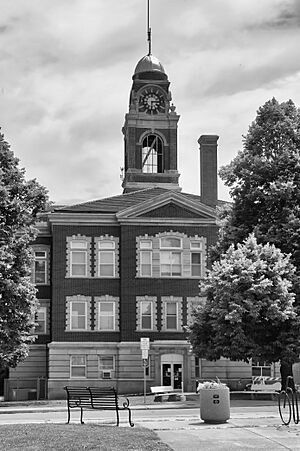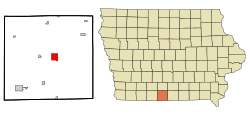Leon, Iowa facts for kids
Quick facts for kids
Leon, Iowa
|
|
|---|---|

Decatur County Courthouse in Leon
|
|

Location of Leon, Iowa
|
|
| Country | United States |
| State | Iowa |
| County | Decatur |
| Area | |
| • Total | 3.14 sq mi (8.13 km2) |
| • Land | 3.13 sq mi (8.11 km2) |
| • Water | 0.01 sq mi (0.02 km2) |
| Elevation | 1,047 ft (319 m) |
| Population
(2020)
|
|
| • Total | 1,822 |
| • Density | 581.74/sq mi (224.60/km2) |
| Time zone | UTC-6 (Central (CST)) |
| • Summer (DST) | UTC-5 (CDT) |
| ZIP code |
50144
|
| Area code(s) | 641 |
| FIPS code | 19-44535 |
| GNIS feature ID | 0468204 |
| Website | http://cityofleoniowa.com |
Leon is a city in Decatur County, Iowa, in the United States. It is the main town, also known as the county seat, for Decatur County. In 2020, about 1,822 people lived there.
Leon is close to the Little River Lake Recreation Area, a great spot for outdoor fun. The city is also famous for its big rodeo event. This rodeo has been named the "Rodeo of the Year" in Iowa many times!
Contents
History of Leon
How Leon Became a City
Leon's story began on April 1, 1850. At first, the main town of the county was Decatur City. But this town often got flooded, making it hard to reach. So, most people in the county decided to move the county seat to a new, drier spot.
The people of Decatur City did not agree with this decision. So, one night, county records were secretly moved by an ox-drawn wagon to the new location! This new settlement was first called Independence. However, there was already another town named Independence in Iowa. It was then briefly called South Independence.
In 1855, a state politician and army veteran named W.H. Cheevers suggested a new name: Leon. He wanted to honor a brave Jewish doctor named David Camden de Leon. The town was officially recognized as a city in 1858. It later became an important shipping point for the Chicago, Burlington and Quincy Railroad.
Geography and Climate
Where is Leon Located?
Leon is located in Iowa, about 12 miles northeast of Lamoni. You can find it along US Route 69 and Iowa Highway 2.
The city covers a total area of about 3.18 square miles (8.24 square kilometers). Most of this area is land, with only a small part being water.
What is Leon's Climate Like?
Leon has a type of weather called a hot-summer humid continental climate. This means it has warm, humid summers and cold winters. The weather changes a lot throughout the year, with clear seasons.
People of Leon
Population Changes Over Time
Leon's population has changed over the years. Here's a quick look at how many people have lived in Leon:
- In 1870, there were 820 people.
- By 1900, the population grew to 1,905.
- In 1940, it reached its highest point with 2,307 residents.
- In 2020, the population was 1,822 people.
Who Lives in Leon Today? (2020 Census)
In 2020, there were 1,822 people living in Leon. There were 743 households, which are groups of people living together in one home.
Most people in Leon are White (about 94.7%). A small number of people are Black or African American, Native American, Asian, or Pacific Islander. About 1.9% of the population identified as Hispanic or Latino.
The average age in Leon was about 39.1 years old.
- About 26.2% of residents were under 20 years old.
- About 22.9% were between 25 and 44 years old.
- About 22.2% were 65 years old or older.
More women live in Leon than men, with about 51.8% female and 48.2% male residents.
Famous People from Leon
Some notable people who have lived in Leon include:
- Steven V. Carter, a politician
- Sarah Bond Hanley, a politician
- John Clinton Porter, a politician
Leon Chamber of Commerce
What is the Chamber of Commerce?
The Leon Chamber of Commerce is an important group that helps local businesses and the community. It works to make Leon a better place to live and work.
The idea for such a group started way back in 1888, when business owners met to form the "Leon Board of Trade." Later, in 1907, the "Leon Commercial Club" was created to help the city grow. Today, this organization is known as the Leon Chamber of Commerce.
The Chamber of Commerce helps bring together businesses and community activities. Its main goal is to support the city of Leon and Decatur County. They work to promote the best interests of the community and help local businesses succeed. In 2013, the Chamber joined with another group, the Leon Community Development Corporation, to work even more closely together.
Education in Leon
Students in Leon attend public schools operated by the Central Decatur Community School District.
See also
 In Spanish: Leon (Iowa) para niños
In Spanish: Leon (Iowa) para niños

